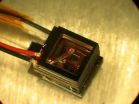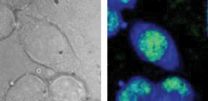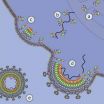(Press-News.org) Researchers from the National Institute of Standards and Technology (NIST) and the German national metrology institute have used NIST's miniature atom-based magnetic sensor to successfully track a human heartbeat, confirming the device's potential for biomedical applications.
Described in Applied Physics Letters,* the study is the first to be performed under conditions resembling a clinical setting with the NIST mini-sensors, which until now have been operated mostly in physics laboratories. The new experiments were carried out at the Physikalisch Technische Bundesanstalt (PTB) in Berlin, Germany, in a building described as having the world's best magnetic shielding—necessary to block the Earth's magnetic field and other external sources from interfering with the high-precision measurements. PTB has an ongoing program in biomagnetic imaging using human subjects.
The NIST sensor—a tiny container of about 100 billion rubidium atoms in gas form, a low-power infrared laser, and optics—measured the heart's magnetic signature in picoteslas (trillionths of a tesla). The tesla is the unit that defines magnetic field strength. For comparison, the Earth's magnetic field is a million times stronger (measured in millionths of a tesla) than a heartbeat, and an MRI machine uses fields several million times stronger still (operating at several tesla).
In the experiments at PTB, the NIST sensor was placed 5 millimeters above the left chest of a person lying face up on a bed. The sensor successfully detected the weak but regular magnetic pattern of the heartbeat. The same signals were recorded using the "gold standard" for magnetic measurements, a SQUID (superconducting quantum interference device). A comparison of the signals confirmed that the NIST mini-sensor correctly measured the heartbeat and identified many typical signal features. The NIST mini-sensor generates more "noise" (interference) in the signal but has the advantage of operating at room temperature, whereas SQUIDs work best at minus 269 degrees Celsius and require more complicated and expensive supporting apparatus.
A spin-off of NIST's miniature atomic clocks, NIST's magnetic mini-sensors were first developed in 2004. Recently, they were packaged with fiber optics for detecting the light signals that register magnetic field strength. (See the 2007 NIST news release "New NIST Mini-Sensor May Have Biomedical and Security Applications" at http://www.nist.gov/public_affairs/releases/magnetometer.cfm.) In addition, the control system has been reduced in size, so the entire apparatus can be transported easily to other laboratories.
The new results suggest that NIST mini-sensors could be used to make magnetocardiograms, a supplement or alternative to electrocardiograms. The study also demonstrated for the first time that atomic magnetometers can offer sensing stability lasting tens of seconds, as needed for an emerging technique called magnetorelaxometry (MRX), which measures the magnetization decay of magnetic nanoparticles. MRX is used to localize, quantify and image magnetic nanoparticles inserted into biological tissue for medical applications such as targeted drug treatments. Further tests of the NIST sensors at PTB are planned.
INFORMATION:
* S. Knappe, T.H. Sander, O. Kosch, F. Wiekhorst, J. Kitching and L. Trahms. Cross-validation of microfabricated atomic magnetometers with SQUIDs for biomagnetic applications. Applied Physics Letters. 97, 133703 (2010); doi:10.1063/1.3491548. Online publication: Sept. 28, 2010.
NIST mini-sensor traces faint magnetic signature of human heartbeat
2010-10-15
ELSE PRESS RELEASES FROM THIS DATE:
Biologists identify influence of environment on sexual vs. asexual reproduction
2010-10-15
TORONTO, ON – Evolutionary biologists at the University of Toronto (U of T) have found that environment plays a key role in determining whether a species opts for sexual over asexual reproduction.
The study, led by post-doctoral student Lutz Becks and Professor Aneil Agrawal of the Department of Ecology & Evolutionary Biology, found that species that inhabit spatially heterogenous environments – habitats characterized by uneven concentrations of its own species among a rich variety of other animals and plants – had higher rates of sexual reproduction than those in more ...
Faster CARS, less damage: NIST chemical microscopy shows potential for cell diagnostics
2010-10-15
A paper by researchers at the National Institute of Standards and Technology (NIST) may breathe new life into the use of a powerful—but tricky—diagnostic technique for cell biology. The paper,* appearing this week in the Biophysical Journal, demonstrates that with improved hardware and better signal processing, a powerful form of molecular vibration spectroscopy can quickly deliver detailed molecular maps of the contents of cells without damaging them. Earlier studies have suggested that to be useful, the technique would need power levels too high for cells.
The technique, ...
New look at multitalented protein sheds light on mysteries of HIV
2010-10-15
New insights into the human immunodeficiency virus (HIV) infection process, which leads to acquired immunodeficiency syndrome (AIDS), may now be possible through a research method recently developed in part at the National Institute of Standards and Technology (NIST), where scientists have glimpsed an important protein molecule's behavior with unprecedented clarity.
The HIV protein, known as Gag, plays several critical roles in the assembly of the human immunodeficiency virus in a host cell, but persistent difficulties with imaging Gag in a lab setting have stymied researchers' ...
New small business law could have big effect on retirement accounts
2010-10-15
CHAMPAIGN, Ill. – A new law aimed at helping stimulate small business job growth through tax deductions could have major consequences for anyone with a retirement savings account at work, a University of Illinois expert on taxation and elder law notes.
Law professor Richard L. Kaplan says an obscure provision in the recently enacted Small Business Jobs Act allows 401(k), 403(b) or 457 account holders to convert their retirement savings into a tax-advantaged Roth-version of the same account.
The good news, according to Kaplan, is that by converting to a Roth variant, ...
This little light of mine: Changing the color of single photons emitted by quantum dots
2010-10-15
Researchers at the National Institute of Standards and Technology (NIST) have demonstrated* for the first time the conversion of near-infrared 1,300 nm wavelength single photons emitted from a true quantum source, a semiconductor quantum dot, to a near-visible wavelength of 710 nm. The ability to change the color of single photons may aid in the development of hybrid quantum systems for applications in quantum communication, computation and metrology.
Two important resources for quantum information processing are the transmission of data encoded in the quantum state of ...
Charcoal biofilter cleans up fertilizer waste gases
2010-10-15
Removing the toxic and odorous emissions of ammonia from the industrial production of fertilizer is a costly and energy-intensive process. Now, researchers in Bangladesh have turned to microbes and inexpensive wood charcoal to create a biofilter that can extract the noxious gas from vented gases and so reduce pollution levels from factories in the developing world.
Writing in the International Journal of Environment and Pollution, Jahir Bin Alam, A. Hasan and A.H. Pathan of the Department of Civil and Environmental Engineering, at Shahjalal University of Science and Technology, ...
Mayo Clinic finds early success with laser that destroys tumors with heat
2010-10-15
JACKSONVILLE, Fla. — Physicians at Mayo Clinic's Florida campus are among the first in the nation to use a technique known as MRI-guided laser ablation to heat up and destroy kidney and liver tumors. So far, five patients have been successfully treated — meaning no visible tumors remained after the procedure.
They join their colleagues at Mayo Clinic's site in Rochester, Minn., who were the first to use laser ablation on patients with recurrent prostate tumors.
Although the treatment techniques are in the development stage, the physicians say the treatment is potentially ...
Perspectives on improving patient care: Genetics, personalized medicine, and behavioral intervention
2010-10-15
Personalized medicine — improving the fit between patient and treatment — has become a major focus of research in fields from cancer treatment to the psychopharmacology of mental disorders. Genetic studies have suggested that an individual's genetic makeup renders him either more or less sensitive to stressful social environments — but can an individual's unique genotype also determine the effectiveness of preventative or therapeutic behavioral interventions?
The current issue of Perspectives on Psychological Science, a journal of the Association for Psychological Science, ...
Study: Waist circumference, not BMI, is best predictor of future cardiovascular risk in children
2010-10-15
Athens, Ga. – A new long-term study published by researchers at the University of Georgia, the Menzies Research Institute in Hobart, Australia and the Murdoch Childrens Research Institute in Melbourne, Australia suggests that waist circumference, rather than the commonly used body mass index measure, is the best clinical measure to predict a child's risk for cardiovascular disease and diabetes later in life.
The researchers, whose results appear in the early online edition of the International Journal of Obesity, found that children with high waist circumference values ...
UT Dallas researcher helps reveal more complete picture of Martian atmosphere
2010-10-15
Instruments designed by a UT Dallas professor to measure atmospheric components on the surface of Mars have uncovered important clues about the planet's atmosphere and climate history.
The findings, published in a recent issue of the journal Science, reveal how carbon dioxide isotopes have reacted to volcanic activity, water and weathering – thus forming a more complete picture of the current Martian atmosphere.
The NASA mission in which this work was accomplished was the Phoenix Lander, an unmanned spacecraft deployed to Mars in 2008.
UT Dallas Physics Professor ...




